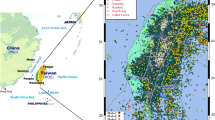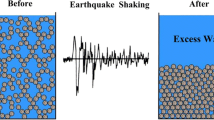Abstract
Liquefaction-induced lateral spreading is known to be a significant type of damage for engineering structures. This research introduces an evolutionary algorithm by using a combination of the group method of data handling (GMDH)–type neural network and genetic algorithm for predicting liquefaction-induced lateral displacements. A new and comprehensive database containing 526 case histories from 18 significant earthquakes is compiled and analyzed to develop a new predictive model. Also, the developed equation evaluated the results of previously published experimental studies and showed an acceptable performance. The obtained results show a more accurate performance of the proposed model compared with previous models. Since the presented model has been developed based on numerous seismic events and site conditions, it is more general and reliable than other models.












Similar content being viewed by others
References
Abdoun, T. H., 1997.Modeling of seismically induced lateral spreading of multi-layered soil and its effect on pile foundations. PHD Thesis, Rensselaer Polytechnic Institute, Troy, New York
Ambraseys NN, Bommer JJ (1991) The attenuation of ground acceleration in Europe. Earth Eng Struct Dyn 20(12):1179–1202
Ambraseys NN, Menu JM (1988) Earthquake induced ground displacements. Earth Eng Struct Dyn 16(1):985–1006
Arulmoli, K.; Muraleetharan, K. K.; Hossain, M. M.; and Fruth, L. S., 1992. Verification of liquefaction analysis by centrifuge studies laboratory testing program soil data.Technical Report, Earth. Tech. Corp., Irvine, California, 404p
Atashkari K, Nariman-Zadeh N, Golcu M, Khalkhali A, Jamali A (2007) Modelling and multi-objective optimization of a variable valve-timing spark-ignition engine using polynomial neural networks and evolutionary algorithms. Energy Convers Manag 48(3):1029–1041
Bandini V, Biondi G, Cascone E, Rampello S (2015) A GLE-based model for seismic displacement analysis of slopes including strength degradation and geometry rearrangement. Soil Dyn Earthq Eng 71:128–142
Bartlet, S. F.; and Youd, T. L., 1992. Empirical analysis of horizontal ground displacement generated by liquefaction-induced lateral spreads. Technical report no. NCEER-91-0021, National Center for earthquake engineering research. State University of New York at Buffalo, NY
Bartlet SF, Youd TL (1995) Empirical prediction of liquefaction-induced lateral spread. J Geotechnical Eng.Div 121(4):316–329
Baziar M\H, Ghorbani A (2005) Evaluation of lateral spreading using artificial neural networks. Soil Dynamics and Earthquake Engineering 25 (1):1-9
Biondi G, Cascone E, Maugeri M, Motta E (2000) Seismic response of saturated cohesionless slopes. Soil Dyn Earthq Eng 20:209–215
Bolton MD (1991) Geotechnical stress analysis for bridge abutment design. Report 270. Transport and Road Research Laboratory, Crowthorne
Cetin KO, Youd TL, Seed RB, Bray JD, Sancio R, Lettis W, Tolga MT, Durgunoglu HT (2002) Liquefaction-induced ground deformations at Hotel Sapanca during Kocaeli (Izmit)-Turkey earthquake. Int J Soil Dyn Earth Eng 22:1083–1092
Cetin KO, Youd TL, Seed RB, Bray JD, Sancio R, Lettis W, Durgunoglu HT, Tolga MT (2004) Liquefaction-induced lateral spreading at Izmit Bay during the Kocaeli (Izmit)-Turkey earthquake. J Geotech Geoenviron Eng 130(12):1300–1313
Chu DB, Stewart JP, Youd TL, Chu BL (2006) Liquefaction-induced lateral spreading in near-fault regions during the 1999 Chi-Chi, Taiwan earthquake. J Geotech Geoenviron Eng 132:1549–1565
Elgamal AW, Zeghal M, Taboada V, Dobry R (1996) Analysis of site liquefaction and lateral spreading using centrifuge testing records. Soil Found J Jap Geotec Soc 36(2):111–121
Finn WDL, Ledbetter RH, Wu G (1994) Liquefaction in silty soils: design and analysis. Ground Failures Seismic ConditionsGeotec Spec Pub 44:51–76
Garcia SR, Romo MP, Botero E (2008) A neurofuzzy system to analyze liquefaction-induced lateral spread.Soil Dyn. Earth Eng 28:169–180
Gu WH, Morgenstern NR, Robertson PK (1993) Progressive failure of lower San Fernando dam. J Geotech Eng 119(2):333–349
Gu WH, Morgenstern NR, Robertson PK (1994) Post-earthquake deformation analysis of wildlife site. J Geotech Eng 120(2):274–289
Hamada M, Towhata I, Yasuda S, Isoyama R (1987) Study on permanent ground displacements induced by seismic liquefaction. Comp Geomec 4:197–220
Holzer T, Bennett MJ, Ponti DJ, Tinsley JC (1999) Liquefaction and soil failure during the 1994 Northridge earthquake. J Geotech Geoenviron Eng 125(6:438–452
Holzer, T.; Noce, T. E.; Bennett, M. J.; Alessandro, C.; Boatwrite, J.; Tinsley, J. C.; Sell, R. W.; and Rosenberg, L. I., 2004. Liquefaction-induced lateral spreading in Oceano, California, during the 2003 San Simeon Earthquake.USGS Open-File Report No. 2004–1269, Version 1.0
Iba H, de Garis H, Sato T (1994) Genetic programming using a minimum description length principle. Adv In Gen Prog 12:265–284
Ivakhnenko AG (1971) Polynomial theory of complex systems.IEEE Trans. SysMng Cyber SMC-1:364–378
Javadi AA, Rezania M, Mousavi Nezhad M (2006) Evaluation of liquefaction induced lateral displacements using genetic programming. J Comp Geotech 33:222–233
Joyner WJ, Boore DM (1991) Strong earthquake ground motion and engineering design. Geotech News 9(1):21–26
Juang, C.H. and Jiang, T. 2000. Assessing probabilistic methods for liquefaction potential evaluation. Geotechnical Special PublicationNo. 107, Soil Dyn. Liquefaction 2000, R.Y.S. Pak and J.Yamamura, eds., ASCE, Reston, VA., 148–162
Kanibir A (2003) Investigation of the lateral spreading at Sapanca and suggestion of empirical relationships for predicting lateral spreading. M.Sc. Thesis, Department of Geological Engineering, Hacettepe University, Ankara
Makdisi FI, Seed HB (1978) Simplified procedure for estimating dam and embankment earthquake-induced deformations. J Geotech Eng Div 104(GT7):849–867
Nariman-Zadeh N, Darvizeh A, Ahmad-Zadeh GR (2003) Hybrid genetic design of GMDH-type neural networks using singular value decomposition for modeling and predicting of the explosive cutting process. Inst Mech Eng 217(B):779–790
Newmark NM (1965) Effects of earthquakes on embankments and dams. Géotechnique 15(2):139–160
Olson SM, Johnson CI (2002) Analyzing liquefaction-induced lateral spreads using strength ratios. J Geotech Geoenviron Eng 134(8):1035–1049
Onwubolu GC (2008) Design of hybrid differential evolution and group method in data handling networks for modeling and prediction. Inform Sci 178:3618–3634
Onwubolu, G.C.; Sharma, S.; Bhartu, D. A., Shankar, D. A., and Katafono, K., 2008. Hybrid particle swarm optimization and group method of data handling for inductive modeling.Proc., Int. Conf. on Inductive Modeling, Kyiv, Ukraine, September 15–19
PEER Website (1999) peer.berkeley.edu/turkey/adapazari, A Collaborative Research by U.C. Berkeley, Brigham Young University, and UCLA with ZETAS, Sakarya University, and Middle East Technical University
Rojahn, C.; Brogan, G. E.; and Siemmons, D. B., 1977.Preliminary report on the San Juan, Argentina earthquake of November 23, 1977: U. S.Geological Survey, Menlo Park
Sanchez E, Shibata T, Zadeh LA (1997) Genetic algorithms and fuzzy logic systems.River edge, NJ: world scientific
Sasajima, T.; Kabouchi, A.; Kohama, E.; Watanabe, J.; Miura, K.; and Otsuka, N., 2005.Liquefaction induced deformation of test quay wall in Kushiro Port during the 2003 Tokachi-oki earthquake.Earthq Eng Soil Dyn, 1-15
Seed, H. B.; Arango, I.; Chan, C. K.; Gomez-Masso, A.; and Ascoli, R. G., 1979.Earthquake-induced liquefaction near Lake Amatitlan, Guatemala.Report No. UCB/EERC-79/27
Sharp KM, Dobry R, Abdoun T (2003a) Centrifuge modeling of liquefaction and lateral spreading of virgin, over-consolidated and pre-shaken sand deposits. Int J Phys Model Geotechnics 2:11–20
Sharp KM, Dobry R, Abdoun T (2003b) Liquefaction centrifuge modeling of sands of different permeability. J Geotech Geoenviron Eng 129(12):1083–1091
Stark TD, Mesri G (1992) Undrained shear strength of liquefied sands for stability analysis. J Geotech Eng 118:1727–1747
Taboada VM, Dobry R (1998) Centrifuge modeling of earthquake-induced lateral spreading in sand. J Geotech Geoenviron Eng 124(12):1195–1206
Tokimatsu K, Kojima H, Kuwayama S, Abe A, Midorikawa S (1994) Liquefaction-induced damage to buildings in 1990 Luzon earthquake. J Geotech Eng 120(2):290–307
Towhata I, Sasaki Y, Tokida KI, Matsumoto H, Tamari Y, Yamada K (1992) Prediction of permanent displacement of liquefied ground by means of minimum energy principle. Soils Foundations, JSSMFE 32(3):97–116
Valsmais A, Bouckovalas G, Papadimitriou A (2010) Parametric investigation of lateral spreading of gently sloping liquefied ground. J Soil Dyn Earthq Eng 30:490–508
Wang J, Rahman MS (1999) A neural network model for liquefaction induced horizontal ground displacement. J Soil Dyn Earthq Eng 18:555–568
Youd TL, Perkins DM (1987) Mapping of liquefaction severity index. J Geotech Eng 113(11):1374–1391
Youd TL, Hansen CM, Bartlett SF (2002) Revised multilinear regression equations for prediction of lateral spread displacement. J Geotech Geoenviron Eng 128(12):1007–1017
Yuan HL, Yang SH, Andrus RD, Juang CH (2003) Liquefaction- induced ground failure: a study of the Chi-Chi earthquake cases. J Eng Geology 17:141–155
Zhang J, Zhao JX (2005) Empirical models for estimating liquefaction-induced lateral spread displacement. J Soil Dyn Earthq Eng 25:439–450
Author information
Authors and Affiliations
Corresponding author
Additional information
Responsible Editor: Zeynal Abiddin Erguler
Rights and permissions
About this article
Cite this article
Farrokhi, F., Firoozfar, A. & Maghsoudi, M.S. Evaluation of liquefaction-induced lateral displacement using a GMDH-type neural network optimized by genetic algorithm. Arab J Geosci 13, 4 (2020). https://doi.org/10.1007/s12517-019-4980-1
Received:
Accepted:
Published:
DOI: https://doi.org/10.1007/s12517-019-4980-1




